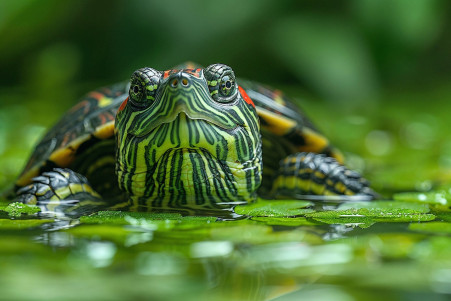Can Box Turtles Swim? What You Need to Know About Their Aquatic Habits
21 February 2024 • Updated 21 February 2024

If you’re familiar with the fact that box turtles are a land-dwelling species, you might be wondering about their relationship with water. And you wouldn’t be alone in your curiosity. The short answer to the question, “Can box turtles swim?” is yes.
Box turtles are primarily land-dwelling animals, but they will enter shallow water to cool off and drink. That said, they are not equipped to handle deep or fast-moving water and need to be able to get in and out of the water easily to avoid drowning.
In this article, we’ll take a deep dive into the fascinating relationship between land and water that defines the lifestyle of box turtles. Drawing on herpetology, wildlife ecology, and ethology, we’ll review the studies that have investigated box turtles’ swimming, including their habits, physical adaptations, and behaviors in and around water.
This information will help you better understand how to care for box turtles and support the conservation of their natural habitats, which will help ensure the survival of these amazing reptiles on land and in water.
Can box turtles swim?
Box Turtles’ Diverse Habitats and the Importance of Water
According to Wikipedia, North American box turtles, which are part of the genus Terrapene, live in a variety of ecosystems including mesic woodlands, grasslands, and even semi-deserts. These ecosystems are found throughout the United States and Mexico and are known for their varied environmental conditions. One thing they all have in common is that they include water sources like ponds and streams that the turtles need for hydration and thermoregulation.
Seasonal behavior is another important part of box turtle biology. As the National Wildlife Federation explains, in the cooler parts of the north, box turtles hibernate in the winter by burrowing into the ground. Water is also important during the active season as it impacts their feeding and cooling behaviors, with younger turtles spending time hunting in water.
Because the conservation statuses of box turtles vary from vulnerable to endangered and are primarily due to habitat destruction and human development, it’s important to protect these diverse ecosystems. These threats can alter the way turtles interact with their environment and limit their ability to perform natural behaviors, including swimming, by restricting their access to the water they need.
Knowing about these ecosystems and the importance of water in them shows how important it is to protect the delicate balance that allows box turtles to survive and thrive. It also shows that when it comes to their ability to swim, it’s important to remember that these behaviors are part of the ecosystems they have evolved to live in over thousands of years.
Understanding the Swimming Habits of Box Turtles
Box turtles are considered to be poor swimmers. However, while they can’t swim as well as their aquatic relatives, box turtles are known to swim and will often spend time in the water, sometimes immersing themselves multiple times a day during the warmer months to cool off or rehydrate, according to Love & Feathers & Shells.
They prefer to swim in shallow, warm water, which allows them to take breaks when they need to and reduces the risk of drowning that comes with deeper or faster-moving water.
How often box turtles swim depends on the individual, although most will swim more frequently when the weather is warmer.
However, it’s important to monitor how often box turtles swim, as too much time in the water can lead to shell rot and other health problems. TurtleHolic recommends that the water in a box turtle’s habitat be shallow enough that the turtle can keep its head above the water and easily climb in and out.
One exception to the rule is the Coahuilan box turtle, which, as All Turtles notes, is more aquatic and spends most of its time in the water. However, no matter the species, all box turtles are sensitive to chlorine, so it’s important to make sure the water they’re swimming in is tepid and dechlorinated.
Knowing this information about box turtles’ swimming habits and the conditions they need to swim in can help you understand how their physical characteristics play a role in their swimming habits.
Exploring the Science of Box Turtle Swimming
Several unique anatomical and physiological characteristics impact the swimming behavior of box turtles. According to Sciencing, one of the most important of these is the fact that the plastron, or bottom shell, of the box turtle is hinged, which allows the turtle to completely close its shell.
While this is a great defense mechanism on land, it has a direct impact on the turtle’s buoyancy and maneuverability in the water. Although the high-domed, rounded shape of the carapace may provide some buoyancy, it is not as hydrodynamic as the flat shells of aquatic turtles, which allows them to move more easily through the water.
In addition, the Smithsonian’s National Zoo notes that the feet of the box turtle are only slightly webbed and have individual toes, while the feet of aquatic turtles are long and fully webbed. This makes the box turtle’s feet less effective for paddling and maneuvering in the water, leading to a less efficient and graceful swimming style.
That said, as Bokanydier observes, box turtles do seem to get around in the water despite these challenges, which is a demonstration of their ability to adapt.
In another example of the turtle’s ability to adapt, the box turtle can regenerate its shell, which is an important evolutionary advantage that would help it recover from injuries in both land and water environments. While the box turtle can’t swim as well as more aquatic turtles, these physical adaptations allow it to access water and meet important needs such as drinking and thermoregulation.
The Aquatic Behaviors of the Box Turtle
The box turtle’s relationship with water goes far beyond the occasional swim. In the wild, box turtles frequently enter shallow water to fulfill a number of physiological needs in their diverse habitats, which range from wet woodlands to dry grasslands.
According to Spruce Pets, box turtles’ habitats need to include shallow water for soaking and drinking, both of which are necessary for their health. Reptile Knowledge notes that box turtles soak to keep clean and cool, especially in the summer when they need to regulate their body temperature.
Water is an important part of the box turtle’s daily life, especially after it rains when they are most active.
The Chattahoochee Nature Center has observed that box turtles seek out springs and seepages in hot, dry weather, showing just how important water is to them.
Unfortunately, human intervention has threatened their habitats and limited their access to water. This shows just how important water is to box turtles. Without it, they would struggle to regulate their body temperature, stay hydrated, and fulfill other biological needs.
It’s important to manage their habitats in a way that ensures these special behaviors can continue unimpeded.
Ensuring the Future: Box Turtle Conservation and Care
Box turtles are currently facing conservation threats, and many populations are listed as species of special concern due to habitat destruction, habitat fragmentation, and roadkill. As both pet owners and nature lovers, we are responsible for helping to ensure their survival.
In order to help box turtles, we need to make sure that we are creating the best possible environment for them in captivity. This means that we need to make sure that we are providing them with the right kind of soil for burrowing and brumation, as the Alabama Wildlife Federation notes.
It is also important to make sure that we are providing water in their enclosures, as box turtles need access to shallow water for soaking and drinking, according to Reptile Knowledge. This means that a water dish that is deep enough for the turtle to get into and cover its legs should be included in their enclosure to mimic the ponds and puddles that they would drink from in the wild.
It is important to make sure that the water is safe and easy to get in and out of to avoid drowning.
By providing a safe environment and speaking out against the illegal pet trade, we can help ensure that these animals will continue to thrive. Caring for box turtles is more than just a fun hobby, it is a way to help ensure that we are protecting the biodiversity and ecological balance of their natural habitat.
Let’s make sure that we are doing our part to protect and care for box turtles and remember the special relationship that they have with the land and water.
The Aquatic Legacy of Land Turtles
In studying the lives of box turtles, we have learned that while they can swim, their swimming is limited by their life on land. As a result, they are not as adept at swimming as their water-dwelling relatives, but they still rely on the water for basic needs like water and temperature regulation.
Their domed shells and webbed, but not fully connected, toes have led to a swimming style that is functional, but not as elegant as that of aquatic turtles.
Knowing the natural and physiological needs of box turtles is important. This information helps us make choices about how to best help them in the wild and in captivity, including the importance of access to shallow water and the risks of deeper water. Going forward, it’s important that we continue to study and work to conserve these animals and their environments.
Box turtles are a perfect example of the balance between land and water, and they demonstrate the adaptability of nature. Their ability to live in both worlds, even if they are limited in each, is a reminder of how delicate ecosystems are and how important it is that we work to protect them. Let’s make sure we continue to learn about and celebrate these tough turtles and make sure their land-water legacy continues.


